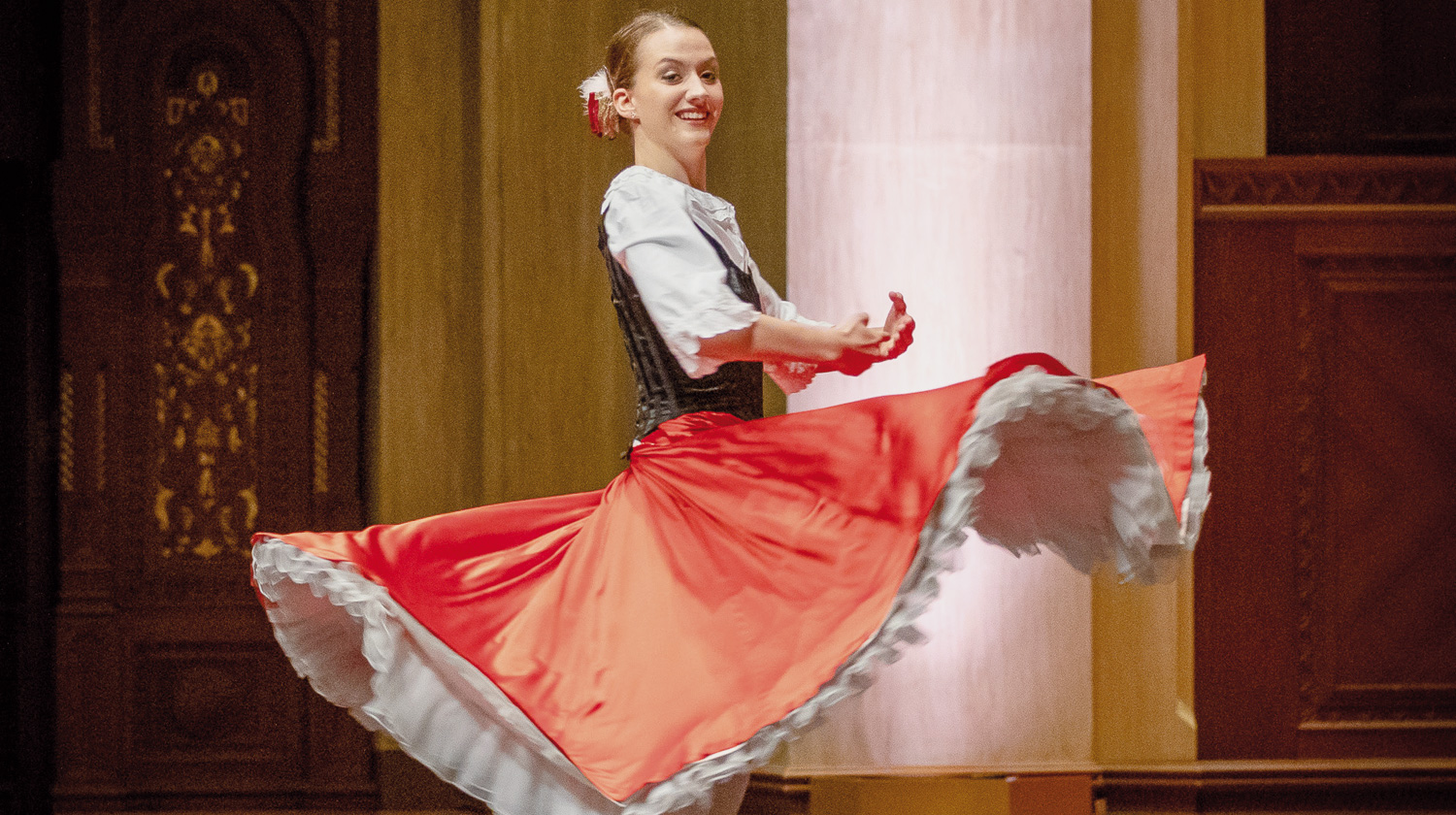

Subtitled, ‘An evening in Vienna’, New Year 2020 was hailed at the Royal Opera House Muscat with a visit to the Austrian capital.
The ‘Vienna Classical Players’ took a diverse section of Muscat’s population on a whistle-stop romp of Waltzes and Polkas for two nights in the packed sold-out auditorium at ROHM.
The two-hour extravaganza featured the founder of the ensemble in 2003, the energetic, animated Martin Kerschbaum, four professional dancing couples from the Weiner Staatsballett and the completely zany, internationally-acclaimed percussionist, Martin Breinschmid.
This was a recipe for a lively, entertaining evening of the Strauss dynasty, yet the varied programme exceeded all expectations and left the audience of various nationalities and many visitors to Oman fairly waltzing out into the night themselves, humming the beloved, ‘Blue Danube’ melody as they headed off to toast the New Year.
The opening piece was Johann Strauss II’s substantial, ‘Waldmeister Overture’ which demonstrated Kerschbaum’s fine handling of the relatively small orchestra.

He pulled back tempos and pushed them forward, the 40 musicians following the conductor with precise timing and clearly enjoying themselves in the lovely acoustics of the hall.
Familiar melodies of a signature Strauss waltz from the woodwind (Simona Pittau, flute), a strong brass section of just five and a beautiful solo from concert master, Dominika Falger, leading a superb string section foretold of great things to come.
Franz Lehar’s ‘Zwanzinette’ was a quirky polka using rim-shots, string bows on wood and bass-drum thumps for amusing descriptive effect, with the glockenspiel giving an appropriate festive feel.
The first appearance of three dancing couples in white from the Weiner Staatsballett came in Eduard Strauss’, ‘Innig und Sinning’, a French Polka both danceable and easy to watch under Mikhail Sosnovschi’s slick choreography.
But the pièce de résistance of the gala came in the pairing of wunderkind percussionist, Martin Breinschmid, with 20th century American composer, Leroy Anderson.
He joined four other ‘soloists’ front of stage, each with three bells and a music stand, to perform Anderson’s syncopated, jazz-waltz, ‘Song of the Bells’. The very tricky fast middle section required precise ensemble timing, with Maestro Kerschbaum getting involved in a spoofy finale. Carl Ziehrer’s fast polka, ‘Flag Salute’ was a return to an orthodox Viennese language, a lively, percussive polka which accelerated into a rousing gallop by the end. But that was short lived; Strauss had his turn at slapstick in his 1869, ‘In Krapfen Woods’ featuring birdsong effects.
Martin Breinschmid played an impressive Cuckoo-impersonator while percussionist Cecilia Martellucci had her moment in the spotlight with orchestral bird-whistles. They had great fun spoofing a bird-tweet competition, vying for prominence until Breinschmid’s cuckoo rudely shouted at the conductor.
However, Martellucci had the last word!

In Part Two, things got even better: Breinschmid came on stage dressed in overalls, wheeling a carpenter’s trolley in a moment of sheer pantomime. Leroy Anderson’s ‘Sandpaper Ballet’ had a distinctly American Broadway feel, with warm string, horn and trombone (Matthias Reindl) sonorities.
However, these were upstaged by Breinschmid’s choreographed virtuoso playing of three sandpaper blocks — in time with the orchestra! A little later came Anderson’s famous, ‘The Typewriter’ Sonata with a Bernstein-style Hollywood film score. There was a mock ‘tune-up’ at the beginning and then a perfectly synchronised performance, typing away with punctuating typewriter bell at the end of each phrase. A short reprise was inserted just to be sure he made no mistakes!
In his ‘Vergnügunszug’ (Pleasure Train) Polka, Johann Strauss kept his tongue firmly in his cheek as piccolo player (Raphael Leone) impersonated a train-whistle and two pairs of dancers in National Dress and Lederhosen provided delightful diversion.
The finale of Part One presented Eduard Strauss’ arrangement of the wonderful tunes in Bizet’s, ‘Carmen Suite’, getting Straussian Oompah and fast Polka treatment juxtaposed with syncopated brass and snare drum rhythms.
Part Two opened with Strauss’ famous Overture from ‘Die Fledermaus’.
Martin Kerschbaum positively ran to the podium with his inexhaustible energy, toying with the tempi to keep the musicians on their toes. There was a beautiful oboe solo from Thomas Karl Machtinger in a delightful performance including the cellos’ rich timbre.
‘Tik-Tak Polka’ (spoken by the orchestra at the end) featured solo dancers, Mihail Sosnovschi and Anastasia Egorova spinning a visual translation of the charming dance story in Austrian National Dress.
The finale of the programme was Strauss’s famous, ‘Roses of the South’ waltz, with all eight dancers in white satin performing a classically romantic ballet. In the limited space their movement combined gesture and pose, leaps and twirls.

sensuous Hungarian gypsy dance with clarinet (Martin Rainer) and violin solos, embellished with percussive tambourine and timpani accompaniment.
The first encore brought Breinschmid to perform a jazz version with virtuoso vibraphone improvisation of, ‘Bei Mir, Bistu Schein’ (made famous by the Andrews Sisters in 1937) allowing the brass to show their jazz colours. He added seven pitched bottles and played the tune on them too, with solos from the two trumpets (Hermann Fiechtl and Eduardo Roman).
The second encore had to be the, ‘Blue Danube Waltz’, taken at a slow tempo then gradually gaining pace as the four ladies returned in blue satin and the men in suits, swirling magnificently while the cello section played the iconic melody with lush, velvety warmth.
There was no holding back, and Kerschbaum ran back on to the podium for a resounding conclusion with Strauss Senior’s 1848, ‘Radetzky March’.
PHOTOS BY KHALID AL BUSAIDI
Oman Observer is now on the WhatsApp channel. Click here



